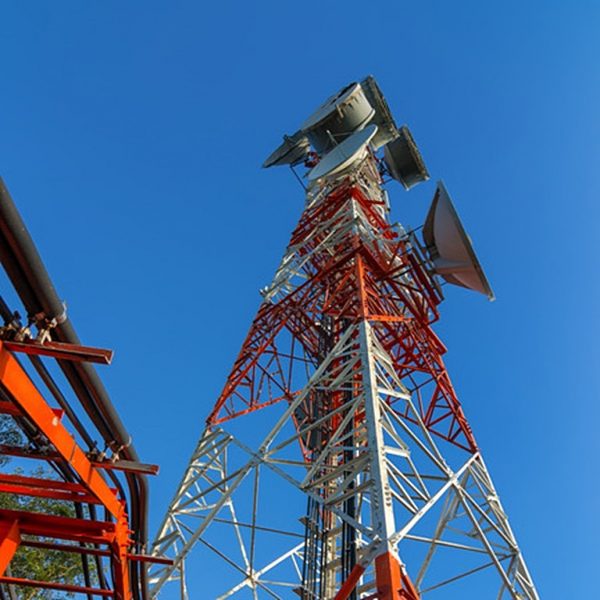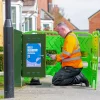Mobile UK Claim Half of People Would Welcome Mobile Mast on their Street

A new survey of over 1,000 adults conducted by industry trade body Mobile UK, which represents mobile operators Three UK, EE (BT), O2 (Virgin Media) and Vodafone, has claimed that 51% of respondents are not bothered or would welcome a new mobile mast on their street to help improve service performance and reliability.
The How Connected Are You? (PDF) survey, which attempts to gauge both the public perceptions of mobile connectivity and attitudes towards mobile infrastructure in the UK, found that 79% of respondents view their mobile as being important, or very important, to them and 81% would find the loss of signal “problematic to their lives” (28% said they can’t live without it).
The survey also revealed that the public understanding of mobile technology is “surprisingly limited“, particularly when you consider that just 14% of people felt confident in their knowledge of mobile connectivity, with 42% admitting to no understanding at all.
Advertisement
Speaking of which, when shown images of common network infrastructure, 45% couldn’t identify a rooftop installation and 35% failed to recognise a mobile phone mast. The confusion became more pronounced in real-world settings: 79% of people couldn’t identify a phone mast in plain sight, and 35% couldn’t recognise any mobile infrastructure at all. Misidentification was also prevalent, with 42% mistaking a TV transmitter for mobile infrastructure and 40% identifying a radio tower.
When questioned about proximity of masts, the results appear to “counter assumptions made about objections to masts“. A clear majority of people – 84%, said they feel it is important to have a mast within range of their home or business. Similarly, 92% understand that a better signal is achieved the closer you are to where it is broadcast from, and 51% said they would not be bothered or would welcome a mast on their street.
Lastly, the survey quizzed respondents who would not like a mast at the end of their road to find out the reasons why. Some 26% said they would not like it on the grounds of aesthetics (even though many had trouble identifying a mobile mast) and only 16% mentioned health concerns.
Gareth Elliott, Director of Policy and Communications for Mobile UK, said:
“What this survey has uncovered is that perceptions and attitudes towards mobile infrastructure have shifted and there is greater awareness of the need for it. These results call into question whether the planning system continues to imbalance its weighting away from the social and economic benefits of connectivity and into the hands of local minorities, of whom often base their objections on false perceptions and limited awareness.”
The results are interesting, and the full survey also covers a lot of other areas (e.g. what we do with our mobile devices), although we do still have to take all of this with a pinch of salt because the sample size was quite small and anything that comes from Mobile UK will inevitably carry a strong air of vested interest.
Advertisement
The study also reminds us a bit of the recent ISPA survey, which similarly found that 75% of respondents “clearly recognise the benefits of having access to faster and more reliable broadband even if that is delivered via poles” (here) – poles being an issue that both the past and present UK government have had to tackle (here). But the larger sample size of the ISPA’s study did lend it more credibility.
Finally, the survey ends by including a series of very familiar recommendations (here, here, here and here), which once again calls for more flexible planning rules and resources to help the deployment of new masts, as well as the appointment of digital champions to help local authorities engage with network operators etc. The new government are looking to reform planning policy (here and here), but the specifics remain unclear.
Recommendations
1. Understanding is crucial to connectivity
Leadership from national and a local authorities and in conjunction with the industry is needed. Better education will safeguard the future of the UK’s connected society.2. Digital Champions
Dedicated roles are needed in every local authority area to help coordinate and prioritise digital connectivity and address digital exclusion.According to Farrpoint 49% of local authorities do not have a digital connectivity strategy that is less than three years old. 47% of authorities have a digital champion but this is part of another role. Only 23% have invested in a dedicated role.
3. Better resourcing in planning
Increasing consumer demand, especially for data, requires mobile operators to invest continually in network coverage and capacity.The planning regimes across the United Kingdom were set down in legislation that pre-dates the move to 5G technologies. Planning regulations and the advice that goes with them must be urgently updated to enable mobile operators to deploy their networks to meet rapidly growing demand. Without this people and businesses will not have access to wider network coverage and the latest technologies.
4. Local leadership
It’s clear while awareness of what constitutes mobile infrastructure is low, the majority of people are somewhat comfortable with new infrastructure. What they are not indifferent to is a scenario where they are unable to access the networks they rely on.More work needs to be done in areas needing new or upgraded infrastructure to convey the facts and debunk myths. Stronger public awareness and engaging in an honest debate with citizens about the benefits and importance of this infrastructure will lead to greater support to facilitate vital infrastructure to safeguard future connectivity.
Mark is a professional technology writer, IT consultant and computer engineer from Dorset (England), he also founded ISPreview in 1999 and enjoys analysing the latest telecoms and broadband developments. Find me on X (Twitter), Mastodon, Facebook, BlueSky, Threads.net and Linkedin.
« O2 UK Launch Cheaper Mobile Social Tariff for People on State Benefits






















































They may say they would be happy for a mast down their street but I bet not right outside their house. Personally I wouldn’t want one down my street.
100%
Would you be okay with a small cell (essentially a small box on a lamp post) like they use in cities?
There’s always someone that finds issue with anything, but the true is, the old way of doing things – a mast somewhere no one sees covering a whole town – doesn’t work when we’re all connected to the internet.
The recommendations look like a cut ‘n paste job with little thought put into it and not much meaning in the words. A marketing wish list to get those pesky regulations (and people) out of the way. And no, I really don’t want a mobile mast on my road. The one a few miles away on a hill will do nicely. In short, I don’t believe a word of it.
Oh Billy… if only physics cared about our opinions.
A mast that is miles away will need frequencies that can reach you. Frequencies that travel further have lower capacity, which means less capacity for data and even a network like O2 is seeing an increase of ~40% of data usage every year. Essentially, that mast miles away is not future proof.
There’s no way around this. We need a more dense network, which each site picking up on the load and using shorter range frequencies with more capacity. It doesn’t have huge ugly masts… there are small cells that can be installed on a lamp post that are small (essentially a small box) and provide capacity to a ~200 meter radius.
In any case, the main point is, the old mast in a hill very far away was enough when everyone was doing regular phone calls. It’s not enough today, where you have people streaming radio, reading news, watching videos, etc.
No thanks
Another survey that’s been weighted to give the response that they wanted. Sometimes a salt mine isn’t big enough……
What a load of cobblers. 50% of people want to reduce the value of their home by 15-20%.
Of course this survey is manipulated but if it was true – let people volunteer to have them outside their homes.
Evidence for the 15-20% claim in areas with masts vs similar areas with no masts?
One of the interesting developments with WiFi calling and WhatsApp etc is that people no longer need a mast in their street… But they still want them in everyone else’s street!
WiFi Calling requires a public WiFi network and broadband. Fine inside a home or café but won’t help you much while walking/driving around the country. It also doesn’t work in every situation or on every device and has some other limits.
Calls and SMS can be done with minimal signal strength. That’s not what you’d want a mast for.
I use 5g as my home internet: I get 300-600Mbps from the mast down the hill but if it was on my street I’d get 2Gbps, as I do standing next to the existing mast.
However I’d rather have FTTP than a cell mast on my street.
Most roads have lampposts
Lampposts could be home to low power equipment that could serve the immediate area.
Masts aren’t needed.
Plenty of preexisting infrastructure to latch onto
Exactly, it would make sense to have small cells in the street rather than trying to get a huge tower with enough wattage to penetrate through loads of walls and buildings. Trouble is, people don’t like these either, you get those that think it makes them ill, to people that think the government is spying on them in their bedrooms. There are already complaints to councils when street lamps appear with a little aerials on top as people think its 5G, when in reliability its for signalling to other lamp posts to turn on and off and/or a mobile phone antenna so they can be remotely controlled and can signal back any faults.
I agree.
However, you’re expecting initiative, communication and collaboration between companies. Good luck with that
There are Karens out there that are also opposed to those solutions…
Imo the karrens should be told without DATA to back up the claims we are going to do it for the best Future possible. Misinformation will be the death of this country. People would stop drinking water if someone said it’s killing you
The government is spying on them in their bedrooms, they just do it through all the data they willingly hand over to Google and Amazon, not through 5G infrastructure.
Millions of lamp posts & telegraph poles, no one moans about them… BUT as soon as a mobile comms pole is mentioned.. ‘we dont want those kind of poles’.
I swear people in this country are crazy.
I get the sense that the anti-mast commentators have been quick to jump in and comment on this story…!
The realists you mean, as I don’t see any “anti mast” commentators, just people saying they wouldn’t want to affect the value of their home.
Of course if not having any mobile coverage affects your house price more or less than having a 30 metre tower outside the front door probably depends on the location, but there’s no doubt both can have an impact.
Personally I have my own amateur radio masts that can put any cell site to shame, but I know I can remove them before I sell and they’re hidden from the neighbours. 🙂
Three had put up a mast at the end of my street earlier this year. I’m really happy they have.
These people who say ‘problematic to their lives’ make me laugh. That’s hilarious. They want the coverage but they don’t want the infrastructure.
Are you a home owner? If so ask the local estate agent if your property price has been impacted, you are in for a very unpleasant surprise.
yes, estate agents, the paragons of honesty/probity. everyone should believe everything they say, always.
Property value shouldn’t come into these things anyway – mobile masts are critical national infrastructure, and we should have as many of them as needed to provide adequate service.
There should be some flexibility for patently poor locations, eg where pedestrian mobility is reduced or putting a noisy cabinet right next to someone’s window, but anything else is really just nonsense. Let’s hope the new government’s claims of planning deregulation do this, and move mobile masts far away from “as bad as landfills” in terms of perceived impact.
I have had a phone mast at the top of my road for a very long time. It recently got upgraded to be a much bigger tower with way more antennae on it but it’s also improved network reliability on Vodafone and introduced 5G for the first time, meaning I actually have a reliable backup if my main internet goes down for the first time ever. A other plus, it also generates income for the local working men’s club that’s been there for years. Would I like to be staring at it all day from my own house? Nope. Is it necessary for modern society to function? Yes.
These masts don’t look any worst than an existing light pillar or an existing telecom post with its messy cabling going to every house, all the messy piping and cabling on the front of houses, endless row of litter box overflowing in the streets, litter and fly tipping everywhere, pot holes and uneven roads.
(Sorry, I don’t know the technical names and english is not my native language).
My grandad used to complain about the electric pillars and wires spoiling the countryside.
My dad used to complain about the telecom wires spoiling our village streets.
I complain about the 5G masts.
My son?
Spot on. Years of DIYers and cowboys adding cabling, conduit, badly planned guttering and soil pipes etc to the front of houses do far more to uglify and devalue a house than a mast in the vicinity.
Actually, more and more people will turn down buying a house if there is poor mobile network coverage. There are more important things we should be concerned about in our streets than a 15 meter mast on a corner. Not that I need to justify it but with all the building improvements recently the value has gone up.
Watch out you will have all the 5G turned me into a zombie people in the comments, oh too late…
It’s crap tech – it won’t make any difference to day to day life.
It’s only impressive if your are static which defeats the whole point.
Even phone companies have halted their original wild claims, it’s a dead duck.
I don’t mind if they put in my garden! 5G are more than welcome!
Ask the right question or indeed the wrong question in a particular way and you too can get the answer you want for any marketing/information gathering/political issue survey. Well proven; loads of documented examples if you look. Whilst it is correct that the use of mobile networks data use is forever increasing no-one other than the operators and providers is actually interested in what it is used for. Quote 28% can’t live without it! so one then wants to ask (which they seemingly didn’t) the simple question – why? I suspect they were most likely the tik tokers and social media post every 30 seconds of their exciting lives; maybe a tad unfair but just get the drift. Define the 1000 adults, were the questions asked in one city or 20? Rural areas? I’m convinced the answers and recognition of kit etc. would vary somewhat. I remember when the early analogue simply phones arrived (business use) which expanded to, ring your mates etc. if you could afford to, then text until the ultimate more computer in your hand than went to the moon. Classic example of creating a market that was never really needed until people perceive the thing as a permanent appendage. Personally yes I have one, low use, handy when out looking for a location when out in unfamiliar areas, emergency but the rest…. no; and I would not want a mast on my doorstep, nor a telegraph pole where previously none existed. Do it like the Victorians; look at some of their water towers and other utility constructions that made infrastructure a joy to look at.
Simple survey, stacked questions to get people to say what they, the surveyors, wanted. I’m all for the locals in the area to be asked if they want poles and masts, not the local authority but the real people. Show them before and after photos. Won’t happen of course.
To those who go “I want better connectivity but don’t you dare put a mast in my street, park, etc” stop being cakeists*.
It’s the same as people who want better home broadband connectivity and go “your not putting up a pole!” or “you’re not digging up my garden!” or “I don’t want a hanging cable!”
You all want the improvements, but with none of the product or the tools that make it happen, and instead decry the installation of service points.
The reality is that very few people are worried about better connectivity.
If Netflix works and broadband is ok Joe Public is more than happy.
Well said, those who are most vocal about not having infrastructure improvements to the local area are highly likely the ones most vocal and complaining about poor mobile coverage, they’re also the ones most likely to only think about themselves and not the wider community.
People have to accept that in some places, you have to have the infrastructure to provide what is a essential service both rural areas and also urban areas especially urban areas that are so congested to the point the network is useless, *looks at O2 as prime example.
I’d quite happily have a dozen telegraph poles containing multiple fibre strands to each house, along with copper wire for redundancy if required. With that I don’t need to have even 3G coverage of my house, in a town/city centre, sure. Along side a motorway or train line, of course. Even out in the sticks it’s needed. But with WiFi speeds & latency eclipsing most 3/4/5g services, high capacity mobile coverage just isn’t needed in homes.
I wonder how they selected the those for the survey,
I wonder how the tick boz answers for formed,
I wonder if ther was a totally unambiguous context.
I don’t want more polution im my private space, just because the emr isnt visible doesn’t mean its not there, just like gamma, X, and ‘cosmic’ rays, the natural ones I can accept as part of life, but man made, we’re losey custondians of the environment.
Perhaps put them in all MP’s and local councilors and mobile operators CxO (past and present) front/back yards first… that ‘lead by example’ idea.